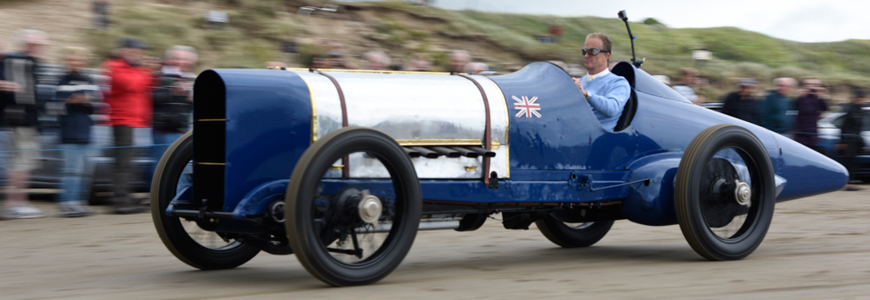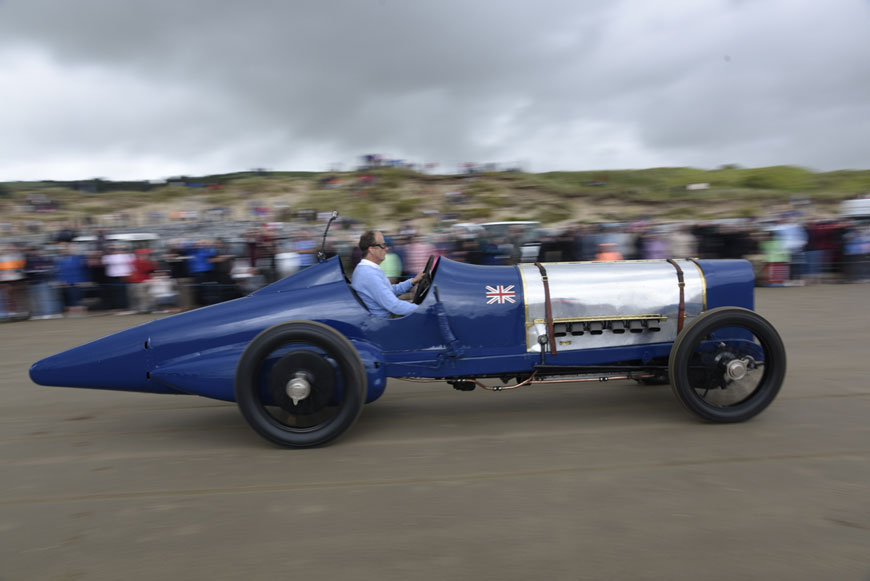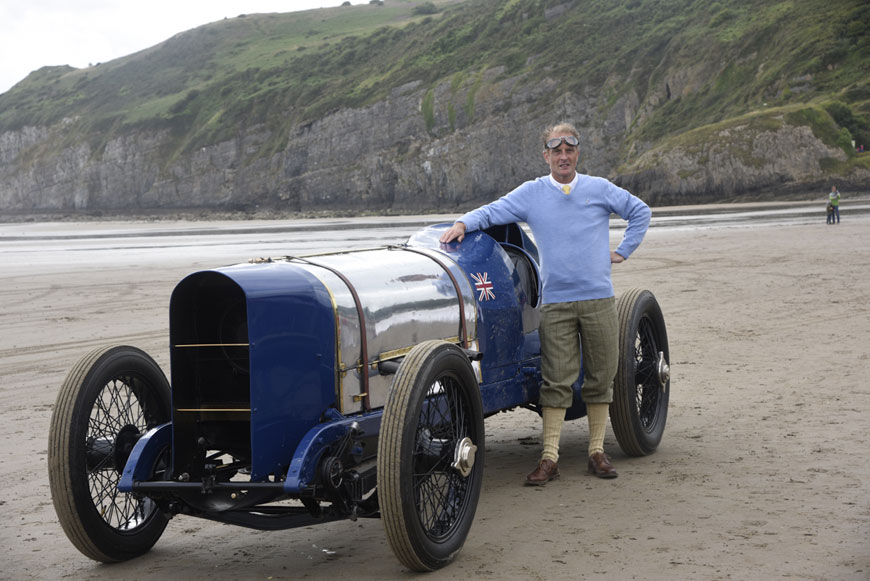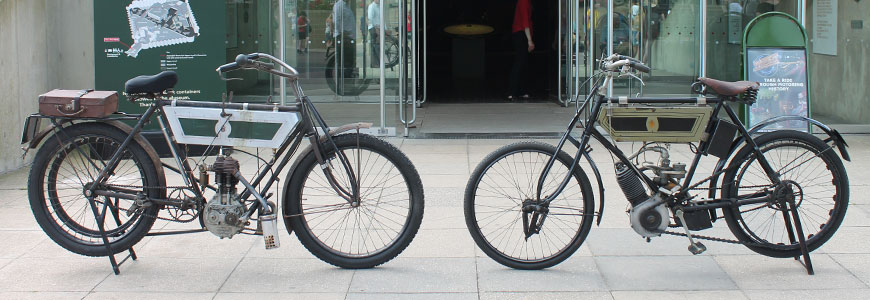“Once I’d stripped down the engine, I discovered that the piston rings were worn out,” explains Mike. “I eventually tracked down a set of new piston rings in Greece, which were shipped over and fitted.” Once the wayward ignition timing had been rectified, it was the turn of the carburettor to cause problems. “The carburettor was leaking like a sieve. Amazingly, replacement carburettors are still manufactured in China, so one of these was ordered and fitted.”
With the Peel back in working order, it was taken for a celebratory spin around the National Motor Museum grounds, but driving such a small vehicle posed certain challenges...
Small is Beautiful
There is only one door and a single headlamp, while three tiny wheels hold the car off the ground. What looks like a long handbrake lever is in fact used for starting the 49cc two-stroke Sachs engine, which is located next to the driver’s right leg. This engine produces 4.2hp, which is sufficient to propel the P50 up to a dizzying 40mph. There may not be a reverse gear, but with a carrying handle mounted on the back, this lightweight car can simply be picked up and manoeuvred by hand.
The museum’s 1964 Peel P50 has been fascinating visitors for many years, but workshop engineer Mike Gillett reckoned that it deserved mechanical rejuvenation. “I just felt sorry for it,” confesses motorcycle enthusiast Mike, “so I decided to get it running again.” However, all was not well with the two-stroke engine.
London to Brighton
Meanwhile, the 1903 and 1904 De Dion Boutons, along with the 1903 Daimler 22hp, were prepared in the workshop to take part in the Bonhams London to Brighton Veteran Car Run. This much-loved annual event follows a 60-mile route from Hyde Park in London to Madeira Drive in Brighton and is a stern reliability test for the pre-1905 cars taking part.
Lord Montagu and his brother Jonathan got behind the wheel for this historic event, as did Museum Manager and Chief Engineer Doug Hill and Senior Engineer Ian Stanfield. It was a foggy start to the day, but thousands of spectators turned out to see these beautiful vehicles attempt the route.



kereta lama yang hebat:

The National Motor Museum, Beaulieu, has launched an appeal to raise funds to build a new gearbox for Sir Malcolm Campbell’s historic 1920 Sunbeam 350hp Land Speed Record car.


The museum’s manager and Chief Engineer, Doug Hill says: “During the Sunbeam’s long and chequered history, its Achilles heel has been a weak gearbox. At some time after WWll, the original gearbox was removed and subsequently lost. It was replaced with a gearbox that was originally used in an Albion 35hp van, designed to take only one tenth of the power this engine produces and the way in which the braking system has been modified means that this installation severely compromises the braking of the vehicle.
“For the next stage of the Sunbeam’s restoration story, we need to build a new gearbox from scratch. As the original gearbox no longer exists and there is no template to follow, this will be a challenge requiring all of our knowledge and expertise. It is a vital step in our journey to restore the car to its 1925 specification and will greatly help us to drive the car closer to the speed it was built for.”
This year celebrates the 90th anniversary of Sir Malcolm Campbell achieving a new World Land Speed record of 150mph at Pendine Sands, South Wales, in this car. On 21 July, ninety years to the day since the record was set, the National Motor Museum marked the occasion with a commemorative low-speed demonstration run with the Sunbeam back at Pendine Sands, with Sir Malcolm’s grandson, Don Wales, in the driving seat.
Commenting on the restoration appeal Don said: “This beautiful car has been lovingly restored and looked after by Doug Hill and the team and its only right that such an iconic car deserves to have the final pieces in place to complete her!”
The appeal for £30,000 has been launched to help fund the work on the gearbox. If you would like to donate to the Sunbeam Appeal you can do so now via BT MyDonate or if you would like to speak to someone in person please contact Heather Reid or email donations@beaulieu.co.uk
The new gearbox will be part of a long term project to restore the car to its 1925 specification. This would also require the fabrication of two full length exhaust pipes, a new seat and upholstery, and the re-manufacture of a slightly dropped nose cone and rear wheel spats.
The Sunbeam, renamed Blue Bird by Campbell, holds three World Land Speed Records, the first achieved by Kenelm Lee Guinness at Brooklands in 1922 with a speed of 133.75mph. Campbell then purchased the car, had it painted in his distinctive colour scheme and in September 1924 achieved a new record speed of 146.16mph at Pendine, raising it the following year to 150.76mph.
Subsequently Campbell sold the Sunbeam and it passed through a number of owners before being purchased, in a very poor condition, by Edward, Lord Montagu in 1957. It was restored to working order and had its last outing at Goodwood in July 1962.
During a test fire-up in 1993 to assess the car’s condition, disaster struck when a blocked oil way in the engine caused it to seize and ‘throw a rod’. For several years after that, the car was on display in the museum with a very visible hole in its engine where the piston and con-rod had exited.
In January 2014, following a complete mechanical rebuild undertaken by the National Motor Museum’s workshop team over a period of many years, the Sunbeam was fired-up again, the first time it had been heard in public in over 50 years. The following month it was a star of the show at Retromobile, Paris and was also run at the Goodwood Festival of Speed.

110-YEAR-OLD MOTORCYCLE RIDES

In 1905, the first model of Triumph motorcycle ever to be fitted with the company’s own engine was ridden on a gruelling 1279-mile road test to prove its reliability. Exactly 110 years to the day, one enthusiast has recreated a 200-mile leg of that journey, motoring from Oxford to Beaulieu and back again.
Nick Jonckheere rode his 1905 Triumph 3hp motorcycle down to the National Motor Museum, where it was met by the museum’s own 1903 Triumph 2.5hp motorcycle, which is thought to be the oldest roadworthy Triumph in the world.
This mammoth trip celebrated the incredible journey made by respected motoring writer the Reverend Basil Davies, who wrote under the name of Ixion. His 1905 road-test was a severe trial for the first motorcycle to have been designed entirely by Triumph. However, the bike’s commendable reliability helped to establish the manufacturer’s reputation as a builder of quality motorcycles.
Although only taking in one leg of the original route, Nick Jonckheere’s 200-mile journey was no small task for a machine over a century old. However, the Triumph took the trip in its stride. “The bike proved to be very reliable on the way to Beaulieu from the New Forest,” said Nick. “Aside from having to adjust the drive-belt, it gave absolutely no trouble at all and used less than a gallon of fuel.”
The engine powers the rear wheel by means of a belt, while auxiliary pedals are connected by a chain. This feature proved very useful. “On steeper hills, assistance by pedalling is called for,” said Nick. “There was only one hill which it didn’t make it up, when I had to get off and push.”
A support car accompanied Nick on the run, driven by fellow Triumph motorcycle owner Paul Gander. “The countryside has changed a lot since 1905, when many of the roads would have just been gravel tracks,” he said. “We tried to keep to the B-roads and away from the busy town centres.”

No comments:
Post a Comment